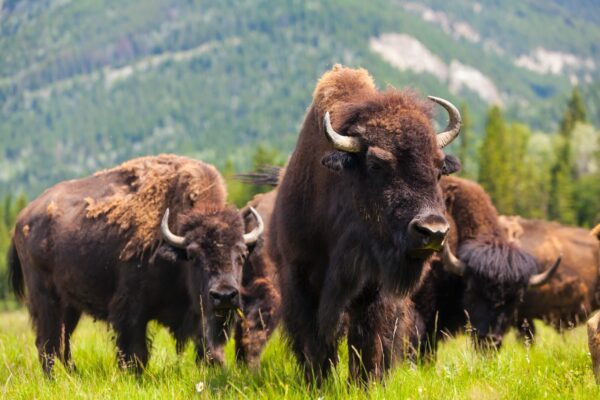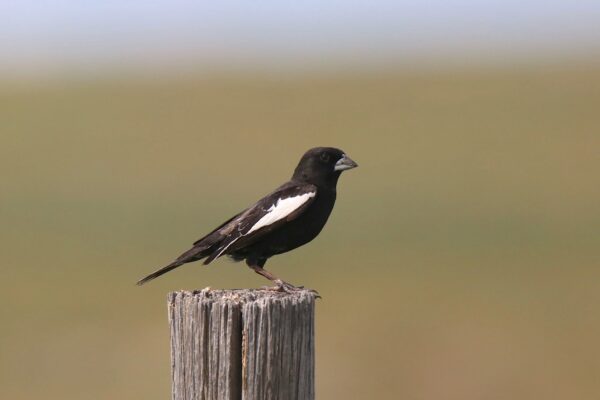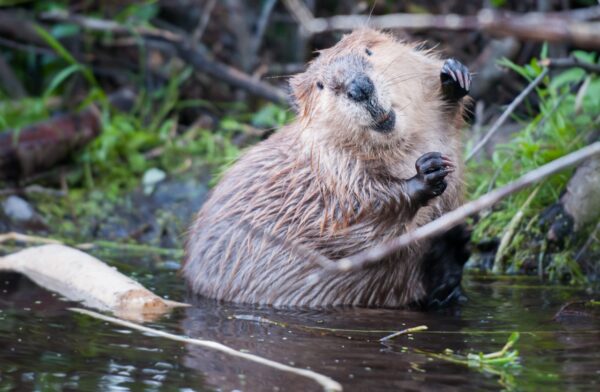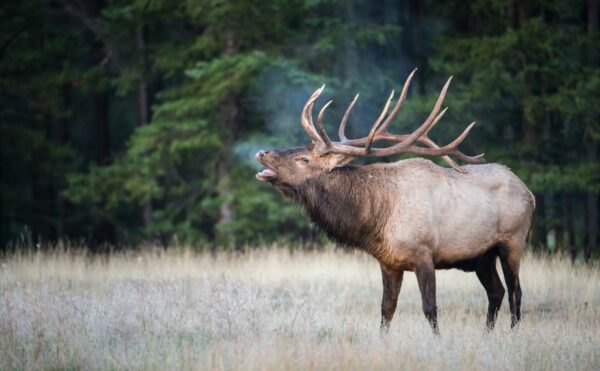Never mind a trip to a wild animal sanctuary or a zoo: If you want a chance to see animals in Colorado, all you need to do is visit Vail.
Located amid the White River National Forest, Vail — a small mountain town and destination ski resort — serves up big opportunities to spot Colorado wildlife in their native habitat. Check out some of the most popular wildlife you’ll see on your trip.
We rounded up some of Vail’s most notable Colorado wildlife to give you a good feel for what’s in store.
Animals in Colorado You’ll See on the Way to Vail

Bison
Which weighs more: A bison or a piano? If you said bison, you are correct. In fact, bison can weigh up to 2,200 pounds — which is nearly three times the weight of the average piano. If you’re driving to Vail from Denver, you will likely spot them grazing near the highway around Genesee Park.
These massive mammals can reach up to 6.5 feet tall, and they’re pretty fast, too. The American bison can hit speeds of up to 40 mph if it ever feels the need to run.
Bison nearly became extinct due to extensive overhunting, but Colorado has been making concerted efforts to help the population bounce back. The state is home to several wildlife preserves, which can double as a wildlife animal sanctuary to help protect a number of native species across the region.
American-Bison Fun Fact: Bison not only weigh more than a piano, but they’re bigger than one, too. Bison are the largest mammals in North America.
Colorado Animals You Might See in the Vail Valley

Bighorn Sheep
With long, curled horns and the ability to stand on cliffs as narrow as 2 inches wide, Rocky Mountain bighorn sheep are a sight to behold — and they’re a common sight in East Vail. Evidently other people thought so, too, as they are the official state animal of Colorado.
One of only four sheep species that live in North America, bighorn sheep are the only sheep found in Colorado. Bighorn sheep typically weigh between 100 and 300 pounds.
Unlike other horned animals like elk and deer, bighorn sheep don’t shed their horns every year. The horns simply continue to grow … and grow … and grow. Male bighorns, or rams, are the ones with the big, curly horns. Female bighorns, called ewes, have smaller, straighter horns.
Bighorn-Sheep Fun Fact: A ram’s pair of horns can weigh nearly 30 pounds.
Bald Eagles, Gold Eagles & More Birds!
Since Colorado boasts more than 400 species of birds, we’re not going to name them all. But we are going to give you a quick rundown about three that make it onto the state’s most popular wildlife list.
-
-
- Bald Eagles
- Golden Eagles
- Lark Buntings
-

Bald Eagles: Found only in North America, bald eagles stand about 3 feet tall and have a wingspan of 6 to 7.5 feet. The only North American bird larger than the bald eagle is the California condor.

Golden Eagles: Another large bird of prey, golden eagles are about the same size as bald eagles, with wingspans that reach up to 7 feet. Adult females are actually larger than the adult males. Fast and agile flyers, they can reach diving speeds of up to 200 mph.

Lark Buntings: As Colorado’s state bird, the lark bunting definitely gets a mention. Members of the sparrow family, lark buntings are about 5 to 7 inches tall with a wingspan of 11 inches. Males have a dark body with white wings. Females have a brownish grey body and stripes. Both, quite frankly, are adorable.
Colorado-Bird Fun Fact: The golden eagle is actually brown. It’s called golden due to the tuft of yellow feathers on its head.
North American Beaver

Seeing a North American beaver may not be common, but spotting a dam along a waterway lets you know they’ve been as busy. Known as “nature’s engineers,” beavers are talented builders indeed.
Colorado beavers build dams as well as lodges. Their lodges usually have insulated walls, floors covered with a comfy coating of wood shavings, and a small air hole on top for ventilation.
Beavers are also incredible swimmers, with the ability to hold their breath for up to 15 minutes under water. About 4 feet long and weighing up to 40 pounds, beavers are much swifter in water than they are on land.
North-American-Beaver Fun Fact: Beavers have orange teeth. No kidding. It’s actually a protective enamel coating that’s rich in iron.
Colorado Wildlife to Keep Your Distance From
Rocky Mountain Elk

If you see a giant pair of antlers attached to a big deer-like creature, you’re most likely looking at a male Rocky Mountain elk. Elk are some of the most popular wild animals seen around Colorado, and they are certainly a sight to behold.
The average male, or bull elk, weighs in at a hefty 700 pounds. He’s the one with antlers. The females, or cow elks, lack antlers and tend to tip the scales at 500 pounds. Either way, you want to avoid elk encounters as they may charge when they feel threatened.
Numbers were down to about 40,000 elk in the early 1900s, but now have rebounded to more than 280,000 in Colorado.
Rocky-Mountain-Elk Fun Fact: A set of antlers from a mature bull elk can weigh about 40 pounds. That’s 10 pounds more than the bighorn sheep’s horns. Here’s what to do if you encounter an elk.
Mountain Lion

Yes, mountain lions can be dangerous animals. They’re also one of the least seen wild animals in the entire state. That’s not to say they don’t exist. They’re just stealthy and prefer to stay hidden.
Their coloring blends in seamlessly in areas with dense pines and bushes, which are their favorite hangouts. Also called pumas, panthers or cougars, mountain lions can reach up to 8 feet long and weigh up to 150 pounds.
Even though mountain lions hunt deer and elk — not humans — attacks can happen if the lion feels scared or threatened. See safety tips for hiking and what to do if you see a mountain lion.
Mountain-Lion Fun Fact: Mountain lions can jump — really jump — up to 15 feet high and cover a distance of 40 feet.
 Moose
Moose
Moose are mighty and magnificent — but they can also be protective and aggressive — unlike the always friendly Bullwinkle. If you encounter a moose, give it space by backing away slowly and always keep pets leashed, especially in areas known to be moose habitat. Explore more tips for what to do if you encounter a moose.
Moose are herbivores, eating pretty much any type of vegetation they can get their mouths on. “Moose” actually means “twig eater,” from the Algonquin words “moz” and “mons.” Moose hair is hollow, which helps them stay afloat while swimming. It also keeps them warm in the winter. Colder climates are a moose’s dream, which is why the snow-covered mountains around Vail are ideal in the winter.
Vail’s summer temperatures are pleasant for moose, and the large beasts like to cool off in bodies of water. Although moose can live up to 20 years in the wild, more than half are typically killed as calves by bears, wolves and other predators.
Moose Fun Fact: Moose can swim. In fact, they can dive 20 feet under the water and hold their breath there for 30 seconds.
Black Bear

Black bears are not as aggressive as their grizzly bear cousins. That doesn’t mean you should run up and hug one. They are known to become aggressive when it comes to protecting their cubs.
Short, stocky and reaching around 5 feet tall when standing on their hind legs, black bears can weigh in at 275 pounds. They are quick on the ground and extremely adept at climbing trees.
As omnivores, black bears eat a variety of foods. Nuts, fruits, seeds and greens are some of their favorites — and they’re keen on picking up the scent of food from several miles away. Protect bears in their natural habitat by keeping food locked away and removing food trash if you’re hiking or camping. See more tips for hiking and camping in Colorado’s bear country.
Black-Bear Fun Fact: You think you have long nails? Black bear claws can grow longer than the typical classroom chalkboard eraser.
Endangered Animals in Colorado

Although efforts have been made to protect and preserve many native species throughout the state, several wild animals are still on the endangered species list. A few notable ones include:
-
-
- Black-Footed Ferret
- Wolverine
- Kit Fox
-
Black-Footed Ferret: Also known as the American polecat, this is the only ferret native to North America. This small mammal hunts and steals the homes of prairie dogs.
Wolverine: When you think wolverine, you may think Michigan — not Colorado. But there may be as many as 100 wolverines living in Colorado. A rare native species, they were once thought to be extinct in the Rocky Mountain State.
Kit Fox: Deep-set eyes and a tiny frame are the claims to fame of the kit fox. That, and their very large, very delicate ears.
Where May You See Wild Animals in Colorado?
When it comes to viewing Colorado wildlife in and around Vail, Vail Mountain is a solid place to start. Ride a gondola up the mountain and you might spot mule deer or black bears on and around the ski trails. Colorado wildlife may also venture from their natural habitat to visit the more urban areas of Vail.
Gore Creek doubles as a wildlife haven, especially in the summer. People have spotted deer, black bears and even a mother moose and calf cooling down near the water.
What to Do if You See a Wild Animal
Remember — as humans, when playing in the Vail Valley’s great outdoors, we are visiting wild animals’ homes. Causing stress for Colorado wildlife — by getting too close, for example — can make it harder for animals to survive, plus it can jeopardize our own safety.
If you see a wild animal, it’s best to stay at least 100 yards from predators (like bear) and at least 25 yards from other animals (like elk). Keeping a safe distance is important, especially if an animal is approaching you, and you should never approach an animal to take a picture of or with it. Learn more about respecting wildlife.
Dos & Don’ts for Respecting Wildlife
DO:
-
-
- Do avoid human contact with animals. Enjoy wildlife viewing from a safe distance.
- Do travel quietly, although you want to make a bit of noise if you’re in areas where black bears are known to roam.
- Do leash/control your dog or other pets at all times.
- Do be especially careful to avoid wildlife during their most sensitive times, such as mating, nesting and raising their young. If a hiking trail is closed seasonally to protect wildlife, please respect that and choose another trail.
- Do travel in small groups. Break up a larger group into several smaller groups if needed.
-
DON’T:
-
-
- Don’t make fast movements or loud noises.
- Don’t touch, pick up or get close to any wild animal. Human encounters are not only stressful for the animal, but they can be harmful to people, too.
- Don’t feed the wildlife. This applies to purposeful feeding as well as inadvertent feeding from leaving food items unsecured. Both purposeful and inadvertent feeding can harm the animals and result in nuisance wildlife issues.
-
More Tips for Enjoying Colorado’s Wildlife
Some of the most glorious and popular wildlife in the U.S. can be found right here in Vail. Take a bike ride, hike or stroll through the area’s natural beauty to see for yourself. You can also gather more information on Colorado animals by visiting the Nature Discovery Center at the top of Eagle Bahn Gondola on Vail Mountain. There are so many reasons to visit Vail, and the array of amazing wildlife species is definitely one of them.










